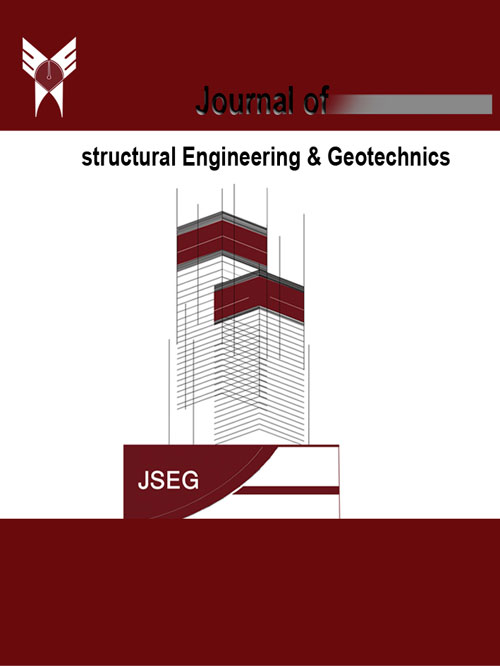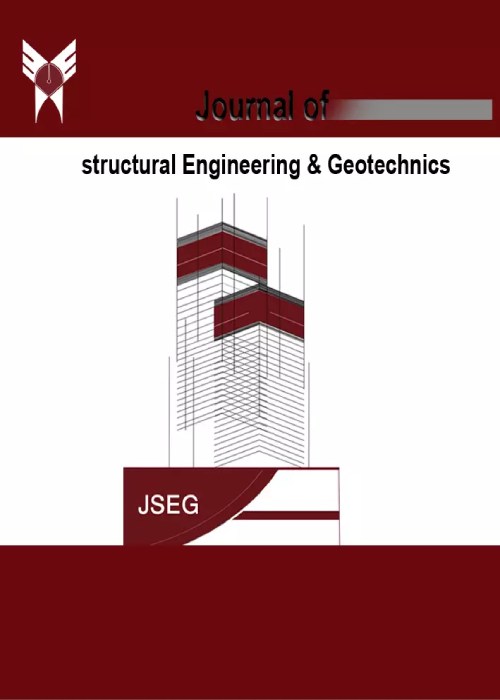فهرست مطالب

Journal of the Structural Engineering and Geotechnics
Volume:5 Issue: 3, Summer 2015
- تاریخ انتشار: 1394/08/30
- تعداد عناوین: 6
-
Pages 1-7Damage to essential facilities (e.g. lifelines and industrial facilities) due to extreme loads may cause remarkable indirect impact as well as direct physical loss. Hence understanding seismic performance of essential facilities is very important in high seismic risk regions. On October 23, 2011 an earthquake of magnitude Mw7.2 occurred in Van province in eastern Turkey. Several damages occurred at industrial plants. Damage to equipment and buildings caused work abandon in some industrial plants. In this paper the observed damage to essential facilities such as transportation systems, silos and gas stations are presented.Keywords: Van Earthquake, Lifelines, damage, Seismic performance
-
Pages 9-14Use of auxiliary elements in refining and betterment of engineering properties of soil have gained attention since a long time ago. Nowadays the effectiveness and capability of the soil reinforcing technique for giving proper practical solutions in various projects have resulted in this technique quickly gaining a place in geotechnical engineering. In this paper, the results of laboratory studies on such characteristics as width and height of the geocell element on load-bearing capacity and settlement of footings have been modelled numerically. It should be noted that the laboratory studies have been carried out in the uniaxial apparatus and analytical studies have been carried out utilizing the finite element software ABAQUS 6.11. by investigating the results it can be seen that in the case of using a geocell element in reinforcing the soil, the load-bearing capacity of the footing increases 1.65 times in comparison with the non-reinforced sample, while settlement in the reinforced footing – with geocell – is only 1.15 times more than the non-reinforced footing. Furthermore when the increase in load-bearing capacity of the footing has a significant importance, the best scenario is increasing the height of the geocell element. But when the footing’s settlement is of significant importance, we can have more effective results by changing the width of the geocell element. By comparing the results from numerical and laboratory studies, an appropriate agreement is observed and in all cases the analytical studies have more conservative results compared to the results from laboratory studies.Keywords: Geocell, Soil Refining, Load, Bearing Capacity of Footings, Numerical, Laboratory Studies
-
Pages 15-20In this paper, the effect of Polypropylene Fibers added to concrete on strength and thermal resistance of high strength concrete has been investigated. Therefore, five tests have been carried out to reach this goal which it includes; effect of weight percent of polypropylene fibers on mechanical properties of concrete, effect of fiber’s length on the strength of high strength concrete, effect of fiber’s volume on the thermal stability of high strength concrete, examine the phenomenon of spalling concrete high resistance against heating, determine the changing of compressive strength of high strength concrete in different temperatures. The results present that the compressive strength has declined with the percentage of fiber concrete after 0.7 kg/m3. Moreover, in all cases the tensile strength and concrete’s bending strength will be increased by fiber content.Keywords: Polypropylene Fibers, Strength, Thermal Resistance, High Strength Concrete
-
Pages 21-26The steel shear wall and composite steel plate shear wall is introduced in recent three decade and is considered and is spread rapidly. Composite steel plate shear wall which is made of a layer of thin steel sheet with coating of reinforced concrete in one or both sides of steel palate is considered a third generation of resistance shear walls against lateral loads that in addition to increasing the strength, ductility and energy absorption, it is very economical and affordable and it is used in constructing high buildings, retrofitting buildings and tanks. In this paper we have tried to examine the seismic behavior of steel and composite shear walls. For this purpose several models of steel shear and composite walls from one to five stories were constructed and analyzed by Abaqus software. The result show that composite steel plate shear walls has more ability to absorb energy, spread produced stress to different parts of the steel plate and ductile than steel shear walls. The curve hysteresis loop of composite steel palate shear walls is more stable and sustainable than steel shear wall. With increasing the number of stories, the initial strength and stiffness is decreased due to increase in lateral shift but the amount of absorbing energy and ductility is increased. The force tolerance in composite steel plate shear wall models is increased in comparison with steel shear wallsKeywords: Steel Shear Wall, Composite Steel Plate Shear Walls, Absorbing Energy, Ductility, Stiffness
-
Pages 27-31In this paper, natural frequencies of the sandwich plates with soft flexible core and composite face sheets are obtained. Three-Dimensional (3D) finite element method (FEM) is used for constructing and analyzing of the sandwich plates to obtain their natural frequencies. Continuity conditions for transverse shear stresses at the interfaces as well as transverse flexibility and transverse normal strain and stress of the core are considered.The effects of plate dimensions such as aspect ratio and thickness ratio are studied. Also, different boundary conditions such as all edges clamped (CCCC), all edges simply supported (SSSS) and combined boundary conditions including (CFCF)are applied to the sandwich plates. Comparison of the present results in special case with those of the accurate plate theories confirms the accuracy of the proposedmodel.Keywords: Finite Element Method, Free Vibration Analysis, Sandwich Plate, Composite Face Sheets, Flexible Core
-
Pages 33-40Rolling-based seismic isolation systems, in which rollers of circular or non-circular section are used, are less expensive and easier to manufacture. However, this type of isolation suffers from either lack of restoring or re-centering capability, or weakness against uplift forces. To resolve the first shortcoming the use of elliptical as well as pillow-shape rolling parts has been suggested, and for the second one, using some uplift restrainers has been proposed. In this paper a kind of base isolating device, called Pillow-Shape Seismic Base Isolation System (PSBIS) is introduced which has both re-centering and uplift-restrained capabilities. The paper is concentrated on derivation of equation governing the motion of PSBIS device. To derive this equation, since the behavior of the device is highly nonlinear the use of Lagrange equation of motion is the most appropriate approach. For this purpose, considering the rotation angle of the pillow-shape roller as the generalized coordinate, the horizontal and vertical components of the pillow-shape roller acceleration have been formulated and the kinetic and potential energy terms as well as the virtual work of the non-conservative, resulted from rolling resistance and seismic forces, have been developed to be substituted in the basic Lagrange equation. To verify the derived equation of motion a simplified sample of the PSBIS device was built and used experimentally, and also the motion of the pillow-shape parts was traced by drawing them in Auto-CAD software. Results show the validity of the derived equation of motion.Keywords: Rolling Resistance, Lagrange Equation of Motion, Differential equation


